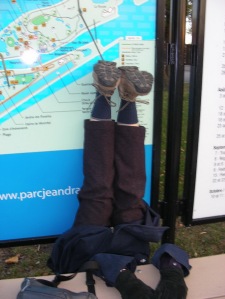Dear Gentle Reader,
Around the time when our youngest child was born, my parents put a swimming pool in their back yard. We used to joke that it was the only way they could get their children to bring their grandchildren to Muskogee, OK in the summer. Like bees to honey, it certainly attracted us, and our four daughters spent time alone with my parents learning to swim, dive. My father loved the chance to teach a new batch of children how to race and win. The design of the pool made it a tax deduction. He was an orthopedist and many of his patients needed rehabilitation that could best be done with pool walking. This pool was 25 ft in length and down one side was an elevated floor the ideal depth for an adult to walk, only the upper torso above water. That was back in 1967, well before water aerobics for rehab and helping arthritis sufferers exercise became an important treatment option.
Water walking is recognized today as easy on the joints and beneficial for those who suffer from osteoarthritis. “The water’s buoyancy supports the body’s weight, which reduces stress on the joints and minimizes pain,” says Jones [Vennie Jones, aquatic coordinator for the Baylor Tom Landry Fitness Center in Dallas]. “And it’s still a great workout. Water provides 12 times the resistance of air, so as you walk, you’re really strengthening and building muscle.” You do not bear weight while swimming and walking, therefore you need to find some exercise that is weight bearing so you don’t lose bone density.
Our YMCA here in West Seattle has at least 2 levels of water aerobics: one mid day for the older, arthritic set and several other opportunities for moderate and vigorous exercise in the water. My husband Chuck found the noon day class gave him a destination for his 1 ½ mile walk three times a week. He loved being one of the only men in a large class of women. They flirted with them and he returned the favor. The pool conversation sometimes rose to such a pitch one could no longer hear the instructor give the calls for the next move. On a few really bad weather days, I joined him, especially when it was too hard for him to walk. So congenial and supportive is this group of about 30 and their patient instructor, that when I took this class two years after Chuck died, they recognized me and asked about his well-being. Now, that is a beneficial reason to join a water aerobics class right there!
Personally, as long as I can get outside to exercise, I will do that over any indoor sport. However, water aerobics for anyone who has joint pain is one of the best ways to get exercise. Get over the inconvenience of changing clothes, getting wet and chilly. Think about the whirl pool hot tub you can soak in (or perhaps your facility has a sauna) and go for it.
If you do not have a Y or club with an aerobics class for people with arthritis, here is a link to a web site that gives detailed descriptions of water walking. Here is an excellent You tube video of other water aerobics moves specifically for arthritics. My personal favorite is playing the piano: the surface of the water is the key board and you lift and lower your fingers while moving your hands from left to right and back pretending to play. The door knob twist is another good one for arthritic hands.
Check with your doctor if you are experiencing a lot of pain. Then take your aching body to the pool. You’ll be amazed at how much better you will feel after moving in that weightless environment for 45 minutes. It will lift your spirits. Our Y has a lift so that even if you are wheel chair bound, you can be helped into the pool.
My readers would enjoy hearing your water aerobics stories. So please share.
Be Well, Do Well and Keep Moving.
Betsy Bell
206 933 1889
www.tirednomore dot com






